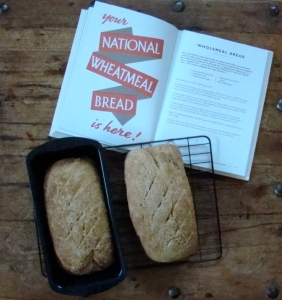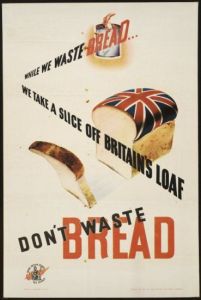 The National Loaf was instituted by the government from 1942 onwards as part of the home front effort during World War II. At the outbreak of war in September 1939, Britain, with a population of around 50 million, was importing 70% of its entire grain requirement.
The National Loaf was instituted by the government from 1942 onwards as part of the home front effort during World War II. At the outbreak of war in September 1939, Britain, with a population of around 50 million, was importing 70% of its entire grain requirement.
The bulk of that imported grain was wheat shipped from Canada across the North Atlantic. Though the ships travelled in protected convoys, they were vulnerable to attack and sinking by German submarines.
 Government planners calculated that it would require thirty ships a year to import the quarter of a ton per year needed to permit every citizen a wholly inadequate daily bread ration of ½ oz (25 gm)!
Government planners calculated that it would require thirty ships a year to import the quarter of a ton per year needed to permit every citizen a wholly inadequate daily bread ration of ½ oz (25 gm)!
And that was wheat for bread alone. (It didn’t include the wheat required for other food products) But shipping on such a grand scale cost money and resources that could be used elsewhere in the war effort therefore the less shipping space required for wheat would mean more space available for war materials.
 But although numerous other food stuffs had been rationed since January 1940, the British government did not want to ration wheat or bread for if it could possibly be avoided. The daily bread then, as now, was not just a basic commodity it was the staff of life.
But although numerous other food stuffs had been rationed since January 1940, the British government did not want to ration wheat or bread for if it could possibly be avoided. The daily bread then, as now, was not just a basic commodity it was the staff of life.
It fell therefore to the Ministry of Food to reduce the amount of imported wheat for bread in order to make the most of what did arrive, whilst continuing to keep bread freely available and ensuring that the population was receiving optimal nutrition value from their food.
In the spring of 1942 the solution they arrived at was to make the wheat they did import go further by the creation of a ‘National Flour’ to create a ‘National Loaf’
 To cope with the reductions in the amount of wheat imported, more flour had to be extracted . It also had added calcium to prevent rickets. The loaf was dense with a dirty grey colour and was unpopular with a population used to white bread. It quickly gained the nickname ‘Hitlers secret weapon’. Unfortunately many people did not find its greyish colour appealing
To cope with the reductions in the amount of wheat imported, more flour had to be extracted . It also had added calcium to prevent rickets. The loaf was dense with a dirty grey colour and was unpopular with a population used to white bread. It quickly gained the nickname ‘Hitlers secret weapon’. Unfortunately many people did not find its greyish colour appealing
Since white flour is generally around 70% extraction the higher 85% extraction rate would yield an extra 15 kg of flour from that wheat. And the population would have a nourishing wholemeal loaf with a high vitamin B content.
 But although the initial extraction rate was 85% it varied over the years. After a short period during which the extraction rate for National Flour was raised to 90% it was in 1944 subsequently reduced to 85% and remained so until August 1950, when it became 81%.
But although the initial extraction rate was 85% it varied over the years. After a short period during which the extraction rate for National Flour was raised to 90% it was in 1944 subsequently reduced to 85% and remained so until August 1950, when it became 81%.
This rate of extraction referred to flour as produced by the mills from the grist supplied. For issue it was usually mixed with a proportion (up to 20%) of imported white flour of lower extraction so that National Flour as delivered was comparable with 82-85% extraction flour.
White flour was still being produced and imported during this period, but it could only be obtained by food manufacturers for items such as biscuits, cakes or for mixing in small quantities into 85% extraction flour to make National Flour. Today, on average we eat less fibre than recommended. But a diet high in fibre has many health benefits. It may help prevent heart disease, diabetes, weight gain and some cancers, and can also improve digestive health.
 Bakers were banned from making any other type of bread except the national loaf. The Federation of Bakers was formed, to assist in organising the wartime production and distribution of bread. Sliced bread was also banned as it was seen as a waste of energy.
Bakers were banned from making any other type of bread except the national loaf. The Federation of Bakers was formed, to assist in organising the wartime production and distribution of bread. Sliced bread was also banned as it was seen as a waste of energy.
A government wartime rhyme was:
“Pat-a-loaf, pat-a-loaf
Baker’s Man
Bake me some Wheatmeal
As fast as you can:
It builds up my health
And its taste is good,
I find that I like
Eating just what I should.
National Loaf recipe:
Ingredients:
(Yields: 10 loaves)
Potato Flour – 1740 gm
Salt Sea Fine – 140 gm
Tap Water – 4740 ml
Vitamin C – 6 gm
Wholemeal flour – 5220 gm
Yeast – 210 gm
Method:
Mix all ingredients in spiral mixer for 3-5 min
Place dough in lightly oiled container, let rest for 45 minutes
Knock back and let rest for another 45 min
Scale at 1kg, first shape (round)
Rest 10-15 min, then second shape
Place bread in oiled baking tins, prove for 45-60 min at 28-32c
Bake at 208 c top 204 c bottom, with 5 second steam. Open vent after 25 min, bake for a further 25 minutes
Remove from tins immediately and cool on a rack.
The National Loaf was finally abolished in October 1956.

